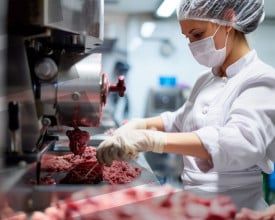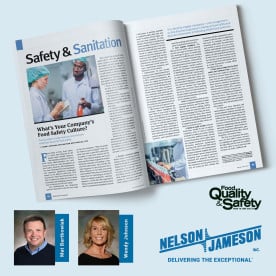Dairy Farm
- May 16, 2017
In February I had the opportunity to attend the “Artisan Dairy Producer Food Safety Initiative Workshop” to learn about the Food Safety Modernization Act (FSMA) along with other leaders in the dairy industry here in Wisconsin. It was put on by the Wisconsin Cheese Makers Association and was offered at no expense thanks to a generous grant from USDA-NIFA. Marianne Smukowski, from the Center for Dairy Research (CDR) and Matt Mathison from the Wisconsin Milk Marketing Board (WMMB) were the trainers for the workshop. The workshop was a brief overview of the expectations that the FDA has put before every business in the food industry, from the large to the small plants. This workshop was geared towards the dairy industry, focusing on the hazards that arise, and how to put a detailed plan together to prevent them. One of the hazards that was of special interest, especially due to the sheer amount of news coverage that it has gotten in the previous months, was the elimination and prevention
- May 08, 2017
The National Conference on Interstate Milk Shipments (NCIMS) is scheduled to meet in May 12-17 in Grand Rapids, Michigan and will be considering a proposal for lowering the maximum allowable somatic cell count (SCC) in milk to 400,000 cells per milliliter. The National Milk Producers Federation (NMPF) has long been a proponent of lowering the SCC threshold to 400,000 cells/ml. The current threshold is 750,000 cells per milliliter. The European Union (EU) and other countries have adopted the 400,000 cell/ml standard, placing import bans on any dairy products sourced from farms with SCCs above that level.
SCC levels measure dead white blood cells in milk, an indication of mammary gland infections. Lower levels of somatic cells indicate higher quality milk. Some federal milk marketing orders have a 350,000 cells/ml threshold to determine milk quality premiums. Dairy processors believe that lower SCC thresholds impact cheese yield, taste and shelf life.
Nelson-Jameson
- October 21, 2015
Nelson-Jameson, Inc. and DSM are proud to announce a new Delvotest® Antibiotic Residue Tests website! Geared towards meeting the needs of dairy farmers, dairy labs, and artisan/farmstead operations, the site features information on an array of kits, troubleshooting tips, and order links.
As part of our mutual commitment to food safety, Nelson-Jameson, Inc. and DSM sought to create a site where users in the Americas could learn more about the dangers of antibiotic residues in milk and how to most effectively select and utilize Delvotest® products to both protect the public health and the economic vitality of their dairy/cheese operations.
To check out the Delvotest® site you can click here, enter “nelsonjameson.com/delvotest” into your web
- October 07, 2015
Nelson-Jameson, Inc. began as a dairy-centric business almost 70 years ago and, while we’ve since branched into all sectors of the food and beverage processing industries, we still consider ourselves experts in all-things-dairy.
Global dairy consumption is expected to grow by 36% in the next decade, largely driven by emerging markets. To satisfy this demand and other culturally-based needs, consumers and processors are looking beyond the traditional dairy cow to other milk-producing animals such as camels, goats, sheep and buffaloes.
- March 26, 2014
The food industry surely sees its share of yeast and mold concerns. Both are relentless aggressors in food deterioration and spoilage that: “can
- October 23, 2013
The publication of the USDA’s “Why Are Americans Consuming Less Fluid Milk? A Look at Generational Differences in Intake Frequency” this May has lead to frank discussion in the dairy industry. Citing a ‘“slow continuous shift downward’ in milk drinking since the 1940s,” the report analyzes the causes and potential effects of this downward trend. The trend has been especially felt significantly in the last several decades: “Since 1970 alone, per capita fluid milk consumption has fallen from 0.96 cup-equivalents to about 0.61 cup-equivalents per day”.
So, what is going on here? The authors point to several issues that have energized this trend including the following: frequency of consumption, a diversified marketplace, and generational differences. In regards to frequency, Americans “have become less apt to drink fluid milk at mealtimes, especially with midday and nighttime meals, reducing the total number of consumption occasions.” Part of the reason the frequency has decreased is due to an expanding array of beverage options that are out there for the average consumer.
Milk has been displaced by the consumption of energy drinks, sodas, juices, tea, coffee, etc. The current market offers a wide selection of beverages, choices, and purported claims. For younger consumers this variety and choice is something they have always known, unlike older consumers who remember fewer choices and a lack of access to Taurine-infused energy drinks, iced teas, iced coffee drinks, chocolate soy milk, etc.






